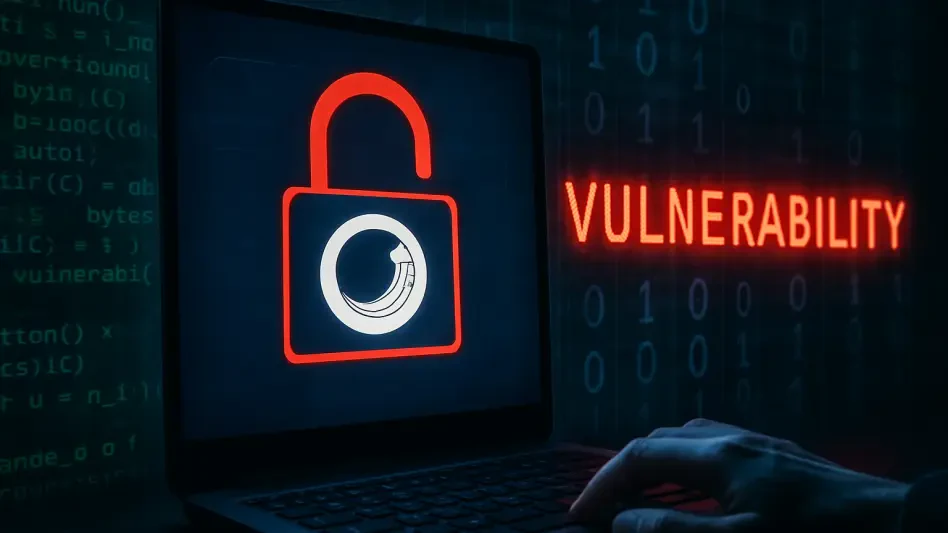Imagine a widely used content management system, trusted by thousands of organizations globally, suddenly becoming a gateway for malicious actors to execute remote code and compromise entire digital infrastructures. This alarming scenario became a reality with the discovery of a critical zero-day vulnerability in SiteCore’s Experience Manager and Experience Platform. Identified as CVE-2025-53690, this flaw has sent shockwaves through the cybersecurity community, exposing systemic weaknesses in configuration practices and documentation. This review delves into the technical intricacies of the exploit, evaluates SiteCore’s response, and assesses the broader implications for CMS security.
Technical Analysis of the Vulnerability
Unpacking the ViewState Deserialization Exploit
At the heart of this zero-day vulnerability lies a ViewState deserialization attack that exploits exposed ASP.NET machine keys. These keys, integral to SiteCore’s framework, were historically published in deployment guides, creating a persistent security gap. Attackers can leverage this flaw to execute arbitrary code remotely on vulnerable systems, effectively gaining unauthorized access to critical infrastructure. The simplicity of exploiting a static key underscores a fundamental oversight in secure design.
This technical flaw is not merely a coding error but a configuration misstep with far-reaching consequences. Mandiant Threat Defense, which conducted an in-depth analysis, highlighted how the static nature of these keys—unchanged for years in some instances—provides a predictable entry point for attackers. The ease of exploiting this vulnerability amplifies its danger, as it requires minimal effort to weaponize once the key is known.
Attacker Expertise and System Exploitation
The sophistication of attackers targeting this vulnerability cannot be overstated. As noted by Mandiant researchers, perpetrators demonstrate an intimate understanding of SiteCore’s architecture, enabling precise targeting of exposed instances. This level of knowledge suggests that threat actors are not merely opportunistic but rather methodical in studying platform-specific weaknesses.
Further insights from Caitlin Condon of VulnCheck reveal how attackers capitalize on publicly available documentation to identify and exploit such flaws. The combination of static keys and accessible guides creates a perfect storm, allowing malicious entities to craft tailored attacks. This scenario emphasizes the critical intersection of technical vulnerabilities and information exposure in modern cyber threats.
Severity and Real-World Impact
The gravity of this vulnerability is evident from its swift inclusion in the Cybersecurity and Infrastructure Security Agency’s (CISA) Known Exploited Vulnerabilities catalog. This designation signals active exploitation in the wild, posing an immediate threat to organizations relying on SiteCore products. The real-world implications are dire, as compromised systems could lead to data breaches, operational disruptions, or worse.
Beyond theoretical risks, the active exploitation of this flaw underscores a pressing need for awareness. Organizations may not even realize their systems are vulnerable until an attack occurs, given the silent nature of remote code execution. This hidden danger amplifies the urgency for proactive measures to identify and address at-risk deployments.
Evidence of ongoing attacks also highlights a broader challenge in the cybersecurity landscape: the speed at which threat actors adapt to newly disclosed vulnerabilities. With SiteCore being a cornerstone for many enterprise digital experiences, the ripple effects of this flaw could impact industries ranging from finance to healthcare, necessitating a rapid response.
SiteCore’s Mitigation and Response Strategy
In response to the discovery of CVE-2025-53690, SiteCore promptly issued security patches to address the deserialization vulnerability. The company has urged users to update their systems immediately and to conduct thorough checks for signs of compromise. This swift action reflects an acknowledgment of the flaw’s severity and a commitment to protecting user environments.
Additionally, SiteCore has provided detailed guidance on securing configurations, emphasizing the importance of replacing static keys with unique, dynamic alternatives. This recommendation aims to close the loophole that attackers have exploited, though it places the onus on administrators to implement changes swiftly. The clarity of these instructions is crucial for ensuring effective remediation.
CISA’s reinforcement of SiteCore’s advisory further validates the urgency of these updates. By aligning with federal cybersecurity recommendations, SiteCore demonstrates a collaborative approach to tackling the issue. However, the effectiveness of these efforts ultimately depends on user adoption, as delays in patching could leave systems exposed to ongoing threats.
Broader Implications for CMS Security Practices
This incident sheds light on systemic issues within CMS platforms, particularly around outdated documentation and insecure configuration defaults. The exposure of static ASP.NET machine keys in historical guides is a stark reminder of how past practices can haunt modern security postures. Such oversights are not unique to SiteCore but reflect a wider challenge in maintaining secure software ecosystems.
Moreover, the exploitation of publicly available information by threat actors points to an evolving trend in cybercrime. Attackers increasingly rely on meticulous research into product documentation, turning benign resources into tools for malicious intent. This dynamic necessitates a reevaluation of how sensitive configuration details are shared or protected by software vendors.
The vulnerability also highlights the importance of continuous security assessments for widely used platforms. As CMS solutions like SiteCore underpin critical business operations, ensuring their resilience against zero-day threats must be a priority. This event serves as a wake-up call for vendors and users alike to prioritize secure-by-design principles over convenience.
Looking Ahead: Strengthening SiteCore Security
Moving forward, SiteCore must address the root causes of this vulnerability by overhauling documentation practices to eliminate references to static keys or other sensitive defaults. Updating guides to reflect current security standards, starting from this year through at least 2027, could prevent similar exposures. Such proactive steps are essential for rebuilding trust among users.
Beyond documentation, there is a clear need for improved configuration tools that enforce secure settings by default. Automating the generation of unique machine keys during deployment could mitigate human error, reducing the likelihood of exploitable setups. Innovations in this area could set a new benchmark for CMS security protocols.
Finally, ongoing vigilance through regular security audits and threat intelligence sharing will be critical. Collaboration between SiteCore, cybersecurity researchers, and federal agencies like CISA can help anticipate and neutralize future zero-day threats. This collective effort is vital for staying ahead of increasingly sophisticated adversaries in the digital landscape.
Final Thoughts and Next Steps
Reflecting on this critical security review, the zero-day vulnerability in SiteCore’s CMS products revealed significant gaps in historical configuration practices that attackers adeptly exploited. The technical depth of the ViewState deserialization attack, coupled with active exploitation evidence, painted a sobering picture of the risks facing enterprise platforms. SiteCore’s response, while timely, underscored the shared responsibility between vendor and user in maintaining a secure environment.
Looking back, the incident served as a catalyst for broader discussions on CMS security, pushing the industry toward stronger safeguards. For organizations using SiteCore, the immediate next step is to apply patches without delay and audit systems for any signs of intrusion. Beyond remediation, adopting a mindset of continuous improvement—through updated configurations and regular training—emerged as a key takeaway.
Ultimately, the path forward demands a strategic focus on integrating security into every layer of digital infrastructure. Exploring partnerships with cybersecurity experts for tailored threat assessments offers a practical solution to bolster defenses. As the landscape evolves, staying committed to adaptive, proactive measures ensures that lessons from this vulnerability shape a more resilient future for CMS technologies.








